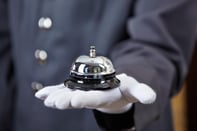Published on
Top 10 Lessons on Continuing Education Management: From the Hotel Industry (Part 3)

This is the conclusion of Emily Richardson’s three-part series, looking at the key lessons she learned about continuing education management from her time as a hospitality manager at a number of hotels and resorts across the United States.
In the first part, Richardson discussed the need to effectively use resources to ensure maximum enrollments, the importance of relationship marketing and the value of defining an institution’s differentiators. In the second part, she shared her thoughts on the importance of customer service and satisfaction. In this article, she shares her top three lessons.
Number 3: Doing more with less
I would have loved to find a job where numbers don’t count, but in both business and higher education, numbers are key components to how one does a job. In the hotel industry, every morning as a general manager, you receive a report on occupancy (the number of beds sold; remember Lesson #10). In addition, there were reports on productivity of the staff (rooms cleaned by a housekeeper, customers served by the restaurant staff), as well as the number of hours worked overtime. Each key metric was measured daily.
The hotel budget was heavily based on staff and service and, thus, little was left over for operations and marketing. You quickly discover it really takes almost the same dollars to serve a few (keeping the lights on costs money) as it does to serve many.
Guess what: the same can be said of continuing education. Budgets are heavily based on staff — in this case, faculty — and few dollars are left for operations and marketing. You discover adding a few more students to a class doesn’t cost you any more, and thus “occupancy” becomes a key performance indicator.
However, I found there were initially few metrics being measured in continuing education. Now that has changed. We do look at the more standard measures, such as enrollments, in terms of credit hours and average number of seats per class. However, we are also now looking at learning outcomes of our students. We are being asked to become more accountable for our actions — something the business world has done all along — and now something higher education must learn to address.
It can’t just be about “smile evaluations;” we must learn to measure and publicize our assessments.
Number 2: Getting the right people on the front lines
Hiring is an art. Whether you are hiring for a front desk employee, a room attendant, a server, a program manager or an instructor, learning how to ask questions to ensure you are getting the right person on your staff is a critical skill for any leader.
The front line employees are the face of your institution to the world. How do they answer the phones? How would they answer a question they know nothing about? How do they treat the customer?
These skills, although they can be taught, are already available in many people. The questions being asked in an interview are critical to hiring the right person for the job, regardless of the industry.
Number 1: Being a leader with a mission, values and enough sense to know when to get out of the way of others!
I hadn’t been in the hospitality industry long when I realized I couldn’t do every job, every day. Hiring (Lesson #2, above) was key to my future success. But then I also learned, since I was hiring people with the right skills and knowledge, sometimes I just needed to get out of their way and let them do their job.
Too many times as leaders, we just refuse to delegate. We believe we can get it done better and faster than those we have hired. That might be true, but then what happens when we really need them to perform, since we have been called away on another emergency? We must work hard to hire correctly, let those we hire perform and then reward them.
It is our job as a leader to provide the vision for where we want the unit to go, what successes we want the group to achieve and what learning outcomes we believe are right to bring our unit value. Can you articulate your vision?
Conclusion
I realize within my top 10 I’ve offered a lot of questions that any leader must be asked and must ask. I’m also convinced if I give this more time, I would find additional similarities between the hospitality and higher education industries. Without question, in both places, the job each day is different from the day before, the challenges are always present and, as a leader, you need to thrive on change. Maybe these will become the beginning of my next list of 10!
This was the final installment of Emily Richardson’s three-part series. To read the first part, please click here. To read the second part, please click here.
Author Perspective: Administrator



